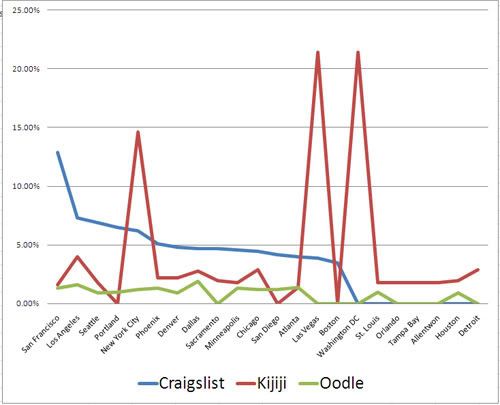Trying to finish up my move, I brought a ton of stuff over to the local Santa Clara Goodwill store / donation center. I was surprised by a few things and finally left wondering how Goodwill can use the web to improve their service and increase their output.

First, the store / donation center was *packed* (mind you it was a Saturday). There were not enough people working at either the store or the donations center to meet the demand.
Second, the quality of donations (obviously) varied drastically. Even within my donations. For example, I donated close to 30 shirts. Some were $5 t-shirts and others were barely worn polo shirts.
So I am left wondering the following: How do they price their donations for sale considering 1) the overwhelming number of items, 2) the underwhelming number of employees, and 3) the significant variance in goods pricing?
I imagine they will struggle to determine the appropriate value for my Polo shirts vs. my t-shirts... and will probably suffer in terms of 'revenue' generated for the organization. From my experience as an eBay employee and seller (200+ feedback), pricing goods in critically important to determining the ability to sell an item quickly and its final value.
Now I have no idea if Goodwill uses software or applications to monitor inventory and determine / move pricing, but there are openings here to leverage work done through other sites with relevant data points - and if a killer app was built, it would has implications far beyond Goodwill's use (think eBay sellers, Craiglist users, and so on):
- eBay's APIs can reveal fair-market pricing for items. I would most likely pull the average price for a brand (not a specific item), include the word used and sell at a marked deduction (say 20%). If it doesn't sell in a week, automatically reduce its price by 5% until it sells. Let's use my clothing donation as an example: for the polo shirt, find the average price for "Polo Shirt" and use their taxonomy to select only: sold items, long sleeves, and pre-worn. There are 2,000+ such items and an average value of something around $40. Sell it for $32 and you now have a price that is both accurate and set to move the product.
- eBay is the ideal source for Goodwill because their inventories map nicely - but for other product categories, Goodwill could look to Amazon (electronics), Craigslist / Kijiji (furniture), etc and then reduce the price by a set amount.
- Moving inventory is critical for Goodwill because they have limited 'retail' space and inventory is constantly streaming in. Thus, I would do two things:
1) As mentioned already, I would continually reduce prices by a fixed percentage based on 'time on shelves'. It needs to move and the space isn't worth the extra $5 it can fetch with the right buyer.
2) Use Craigslist, Kijiji and Postlets to drive traffic. All of these sites do terrific jobs driving demand for items. Just post an ad for a "Garage Sale" on all three sites and you'll get enough replies to fill your inbox. If Goodwill can move their inventory list online (see below) - they can now bulk load it to sites like Craigslist and Kijiji through aggregators like Postlets. Not only will this deliver demand to the stores, it showcase Goodwill's inventory and hopefully attract new, local consumers.... after all, Craigslist and Kijiji have proven that buyers will travel anywhere for a deal.
So - how does Goodwill get their inventory online (or, at the least, into a spreadsheet) in an effective, automated manner? There are a couple ways: Instead of giving people carbon copies of receipts (which are poorly itemized anyhow), set up a portal that allows users to itemize there and receive an emailed copy later. The cost would be minimal (and would be made up quickly) and donors would love the option (I will certainly lose my receipts!). Finally, when items are priced on eBay (and equivalents), store that price electronically and map it to inventory... next time a long sleeved polo shirt is donated, a 'price sold' will be available.
And if you want to get really creative, the items could be bulk loaded and showcased online. I don't think this is worthwhile on an item-by-item basis, but there was enough great 'stuff' available that it could make sense to showcase...
 An ironic tag-line for Google's Print & Radio Platform
An ironic tag-line for Google's Print & Radio Platform







